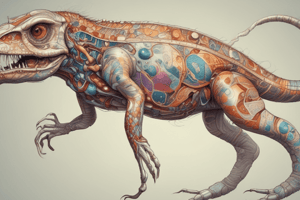Podcast
Questions and Answers
What is the primary function of ventilation in vertebrates?
What is the primary function of ventilation in vertebrates?
- To regulate body temperature
- To control muscle contraction
- To maintain blood pressure
- To facilitate gas exchange (correct)
Which muscles are primarily responsible for expanding and deflating the thoracic cavity?
Which muscles are primarily responsible for expanding and deflating the thoracic cavity?
- Abdominal muscles
- Neck muscles
- Breathing muscles (diaphragm, intercostal, and accessory muscles) (correct)
- Back muscles
What is the primary function of the rib cage in ventilation?
What is the primary function of the rib cage in ventilation?
- To facilitate digestion
- To provide a mechanical advantage for breathing muscles (correct)
- To protect the heart
- To regulate blood flow
Which type of ventilation is used by aquatic vertebrates?
Which type of ventilation is used by aquatic vertebrates?
What is the primary function of countercurrent exchange in fish and some amphibians?
What is the primary function of countercurrent exchange in fish and some amphibians?
What is the primary function of gas bladders in some fish?
What is the primary function of gas bladders in some fish?
What is the primary function of book lungs in some arachnids?
What is the primary function of book lungs in some arachnids?
What is a general trend in the evolution of ventilatory mechanisms in vertebrates?
What is a general trend in the evolution of ventilatory mechanisms in vertebrates?
Flashcards are hidden until you start studying
Study Notes
Ventilatory Mechanisms of Vertebrates
Overview
- Ventilation is the process of moving air in and out of the lungs to facilitate gas exchange
- Vertebrates have evolved different mechanisms to achieve ventilation, depending on their environment and body plan
Mechanisms
- Breathing muscles: diaphragm, intercostal muscles, and accessory muscles (e.g. scalene, sternocleidomastoid)
- Contraction and relaxation of these muscles expand and deflate the thoracic cavity, creating pressure gradients for air to flow in and out
- Rib cage: provides a mechanical advantage for breathing muscles to expand and contract the thoracic cavity
- Lung structure: alveoli, bronchi, and trachea are adapted for gas exchange and air flow
- Nervous control: brainstem and spinal cord regulate breathing rate, depth, and rhythm through neural signals
Types of Ventilation
- Buoyancy-based ventilation: used by aquatic vertebrates (fish, amphibians), where the swim bladder or lungs provide buoyancy to facilitate gas exchange
- Tidal ventilation: used by terrestrial vertebrates (reptiles, birds, mammals), where the diaphragm and rib cage expand and contract to move air in and out
- Asynchronous ventilation: used by some reptiles, where the two lungs ventilate independently to increase oxygen uptake
Adaptations
- Countercurrent exchange: found in fish and some amphibians, where the direction of blood flow is opposite to the direction of oxygen flow, increasing oxygen uptake
- Gas bladders: found in some fish, which provide additional oxygen storage and buoyancy
- Book lungs: found in some arachnids, which provide a more efficient gas exchange surface area
Evolutionary Trends
- Increased efficiency: ventilatory mechanisms have evolved to increase oxygen uptake and carbon dioxide removal in response to changing environments and energetic demands
- Diversification: different vertebrate groups have developed unique ventilatory mechanisms adapted to their specific environments and body plans
Ventilatory Mechanisms of Vertebrates
Basics
- Ventilation is the process of moving air in and out of the lungs to facilitate gas exchange
- Vertebrates have evolved different mechanisms to achieve ventilation, depending on their environment and body plan
Mechanisms
- Breathing muscles (diaphragm, intercostal muscles, accessory muscles) contract and relax to expand and deflate the thoracic cavity, creating pressure gradients for air to flow in and out
- Rib cage provides a mechanical advantage for breathing muscles to expand and contract the thoracic cavity
- Lung structure (alveoli, bronchi, trachea) is adapted for gas exchange and air flow
- Nervous control (brainstem and spinal cord) regulates breathing rate, depth, and rhythm through neural signals
Types of Ventilation
- Buoyancy-based ventilation: used by aquatic vertebrates (fish, amphibians), where the swim bladder or lungs provide buoyancy to facilitate gas exchange
- Tidal ventilation: used by terrestrial vertebrates (reptiles, birds, mammals), where the diaphragm and rib cage expand and contract to move air in and out
- Asynchronous ventilation: used by some reptiles, where the two lungs ventilate independently to increase oxygen uptake
Adaptations
- Countercurrent exchange: found in fish and some amphibians, where the direction of blood flow is opposite to the direction of oxygen flow, increasing oxygen uptake
- Gas bladders: found in some fish, providing additional oxygen storage and buoyancy
- Book lungs: found in some arachnids, providing a more efficient gas exchange surface area
Evolutionary Trends
- Ventilatory mechanisms have evolved to increase oxygen uptake and carbon dioxide removal in response to changing environments and energetic demands
- Different vertebrate groups have developed unique ventilatory mechanisms adapted to their specific environments and body plans
Studying That Suits You
Use AI to generate personalized quizzes and flashcards to suit your learning preferences.




